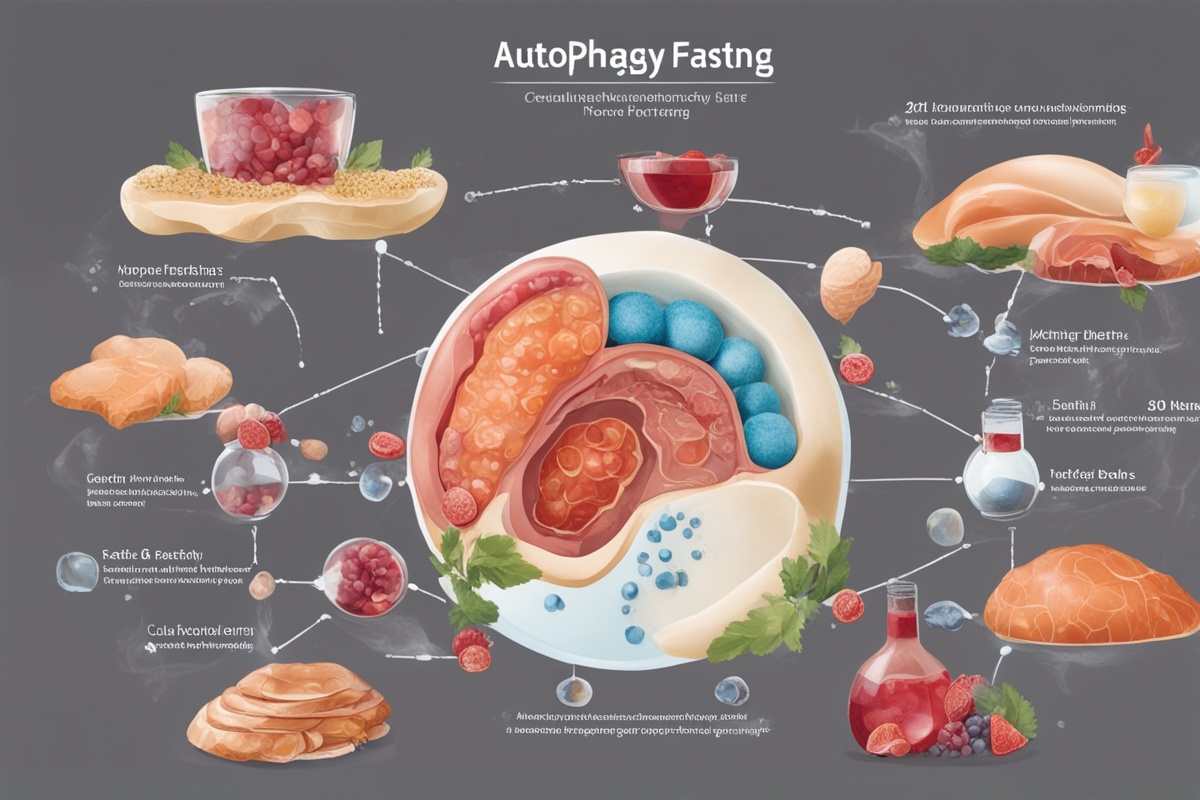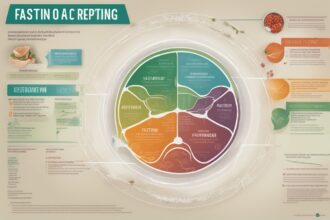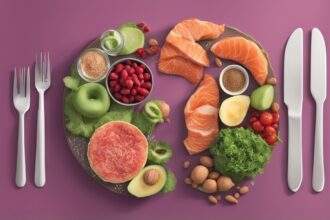Have you ever wondered if your body has a built-in mechanism to clean up and renew itself at the cellular level? Well, it does, and it’s called autophagy. When combined with fasting, this natural process can become a powerful tool for improving health, longevity, and overall well-being. In this deep dive into autophagy fasting, we’ll explore what autophagy is, how fasting triggers it, the science behind its benefits, and practical ways to incorporate fasting into your lifestyle. Whether you’re a seasoned faster or just curious about how to optimize your health, this guide will provide you with actionable insights and evidence-based information. Let’s unlock the secrets of cellular renewal together!
What Is Autophagy and Why Does It Matter?
Autophagy, derived from the Greek words for “self-eating,” is a cellular process where your body breaks down and recycles damaged or unnecessary components within cells. Think of it as a housekeeping mechanism—your cells clean up debris, misfolded proteins, and dysfunctional organelles to maintain optimal function. This process is critical for cellular health and plays a role in preventing diseases like cancer, neurodegenerative disorders, and infections (Levine & Kroemer, 2019). Without autophagy, cellular waste would accumulate, leading to dysfunction and accelerated aging.
What’s fascinating is that autophagy isn’t just a passive process; it can be activated under specific conditions, such as nutrient deprivation. This is where autophagy fasting comes into play. By restricting food intake for certain periods, you create an environment where your body shifts from growth mode to repair mode, ramping up autophagy to preserve energy and resources. It’s like hitting a reset button for your cells, and the implications for health are profound.
How Does Fasting Trigger Autophagy?
Fasting, particularly intermittent fasting or prolonged fasting, is one of the most effective ways to stimulate autophagy. When you stop eating, your body’s energy demands shift. Without a steady supply of glucose from food, insulin levels drop, and your body begins to rely on stored energy sources like glycogen and fat. This metabolic switch also signals cells to activate autophagy to recycle internal components for energy and raw materials (Bagherniya et al., 2018).
The process often kicks into high gear after 12–16 hours of fasting, though the exact timeline can vary based on factors like age, activity level, and diet before fasting. During extended fasts (24–72 hours), autophagy may become even more pronounced as the body prioritizes survival and repair over growth. This is why many health enthusiasts are turning to fasting for autophagy as a strategy to enhance cellular cleanup and combat aging. However, it’s not just about starving yourself—balance and timing are key, as we’ll discuss later.
The Science-Backed Benefits of Autophagy Fasting
The benefits of combining autophagy and fasting go beyond just “feeling good.” Research has uncovered a range of potential health advantages, many of which are tied to how autophagy protects and rejuvenates cells. Let’s break down some of the most compelling benefits supported by science:
- Cellular Longevity: Autophagy removes damaged mitochondria and proteins, which can reduce oxidative stress and slow cellular aging (Rubinsztein et al., 2011). This may contribute to a longer, healthier lifespan.
- Improved Metabolic Health: Fasting-induced autophagy can enhance insulin sensitivity and regulate blood sugar levels, potentially lowering the risk of type 2 diabetes (Bagherniya et al., 2018).
- Neuroprotection: Autophagy plays a role in clearing toxic proteins linked to Alzheimer’s and Parkinson’s diseases, offering potential protection for brain health (Menzies et al., 2017).
- Immune System Support: By clearing out pathogens and damaged cells, autophagy strengthens the immune response, helping your body fight infections more effectively (Levine & Kroemer, 2019).
These benefits highlight why autophagy through fasting has gained so much attention in the health and wellness community. While research is still ongoing, the evidence suggests that this practice could be a game-changer for preventing chronic diseases and promoting overall vitality.
Types of Fasting to Activate Autophagy
Not all fasting methods are created equal when it comes to triggering autophagy. The duration and structure of your fast can influence how effectively your body ramps up this cellular process. Here are some popular fasting approaches to consider if you’re interested in fasting to induce autophagy:
- Intermittent Fasting (16/8 Method): This involves fasting for 16 hours and eating within an 8-hour window. It’s a beginner-friendly way to dip your toes into autophagy fasting, as it often pushes your body into a mild state of nutrient deprivation overnight.
- 24-Hour Fasting: Also known as “eat-stop-eat,” this method involves a full day of fasting once or twice a week. It’s more intense and may enhance autophagy more significantly due to the prolonged nutrient restriction.
- Prolonged Fasting (48–72 Hours): Extended fasts are thought to maximize autophagy, as the body fully depletes glycogen stores and shifts into deeper repair mode. However, this should only be done under medical supervision, especially for beginners.
- 5:2 Diet: This approach involves eating normally for five days of the week and restricting calories (500–600) on two non-consecutive days. While less intense, it can still promote autophagy on low-calorie days.
- Time-Restricted Eating (TRE): Similar to 16/8, TRE limits your eating window to 4–6 hours daily. It’s another accessible way to encourage cellular cleanup without extreme deprivation.
Choosing the right fasting method depends on your lifestyle, health goals, and experience level. If you’re new to autophagy fasting benefits, start with something sustainable like intermittent fasting before progressing to longer fasts.
Practical Tips for Maximizing Autophagy Through Fasting
Now that you understand the science and benefits of fasting and autophagy, how do you put it into practice? Activating autophagy doesn’t have to be complicated, but it does require mindfulness and preparation. I’ve compiled some practical tips based on both research and real-world experience to help you get started and stay on track.
First, ease into fasting if you’re a beginner. Jumping straight into a 72-hour fast without preparation can be overwhelming and counterproductive. Start with a 12-hour overnight fast (simply skipping breakfast) and gradually increase the fasting window as your body adjusts. Hydration is also crucial—drink plenty of water during your fast to support cellular processes and prevent dehydration, which can hinder autophagy (Galluzzi et al., 2017).
Another tip is to focus on nutrient-dense foods during your eating windows. While fasting triggers autophagy, refeeding with high-quality proteins, healthy fats, and antioxidants can support cellular repair post-fast. Avoid overloading on processed sugars and carbs, as they can spike insulin and potentially dampen the autophagy process. Additionally, consider incorporating exercise like light walking or yoga during fasting periods—moderate activity can further stimulate autophagy without overtaxing your body (He et al., 2012).
Lastly, listen to your body. fasting isn’t a one-size-fits-all solution, and pushing yourself too hard can lead to stress or fatigue, which may counteract the benefits. If you feel dizzy, irritable, or unwell, break your fast and consult a healthcare professional. Remember, the goal of autophagy fasting is to enhance health, not to cause harm.
Potential Risks and Considerations
While the benefits of autophagy with fasting are exciting, it’s important to approach this practice with caution. Fasting isn’t suitable for everyone, and there are potential risks to consider. For instance, prolonged fasting can lead to nutrient deficiencies, muscle loss, or electrolyte imbalances if not done properly. People with certain medical conditions, such as diabetes, eating disorders, or pregnancy, should avoid fasting unless under strict medical supervision (Galluzzi et al., 2017).
Moreover, over-activating autophagy through excessive fasting might have unintended consequences. While moderate autophagy is protective, excessive cellular breakdown could potentially harm healthy tissues or disrupt normal function, though more research is needed in this area (Rubinsztein et al., 2011). The key takeaway? Balance is everything. Work with a healthcare provider or nutritionist to ensure that your fasting regimen aligns with your unique needs and health status.
As we’ve explored, autophagy fasting offers a remarkable way to tap into your body’s natural ability to heal and renew itself. From enhancing cellular longevity to supporting metabolic and brain health, the science behind fasting-induced autophagy is promising and continues to grow. By choosing a fasting method that fits your lifestyle, starting slowly, and prioritizing nutrition and hydration, you can harness the power of autophagy to optimize your well-being. Remember, this isn’t about quick fixes—it’s a long-term commitment to health. So, why not experiment with a short fast and see how your body responds? Share your thoughts or experiences in the comments—I’d love to hear how fasting for cellular renewal works for you!
References
- Bagherniya, M., Butler, A. E., Barreto, G. E., & Sahebkar, A. (2018). The effect of fasting or calorie restriction on autophagy induction: A review of the literature. Ageing Research Reviews, 47, 183–197. https://doi.org/10.1016/j.arr.2018.08.004
- Galluzzi, L., Pietrocola, F., Levine, B., & Kroemer, G. (2017). Metabolic control of autophagy. Cell, 159(6), 1263–1276. https://doi.org/10.1016/j.cell.2014.11.006
- He, C., Bassik, M. C., Moresi, V., Sun, K., Wei, Y., Zou, Z., … & Levine, B. (2012). Exercise-induced BCL2-regulated autophagy is required for muscle glucose homeostasis. Nature, 481(7382), 511–515. https://doi.org/10.1038/nature10758
- Levine, B., & Kroemer, G. (2019). Biological functions of autophagy genes: A disease perspective. Cell, 176(1-2), 11–42. https://doi.org/10.1016/j.cell.2018.09.048
- Menzies, F. M., Fleming, A., & Rubinsztein, D. C. (2017). Compromised autophagy and neurodegenerative diseases. Nature Reviews Neuroscience, 16(6), 345–357. https://doi.org/10.1038/nrn3916
- Rubinsztein, D. C., Mariño, G., & Kroemer, G. (2011). Autophagy and aging. Cell, 146(5), 682–695. https://doi.org/10.1016/j.cell.2011.07.030






